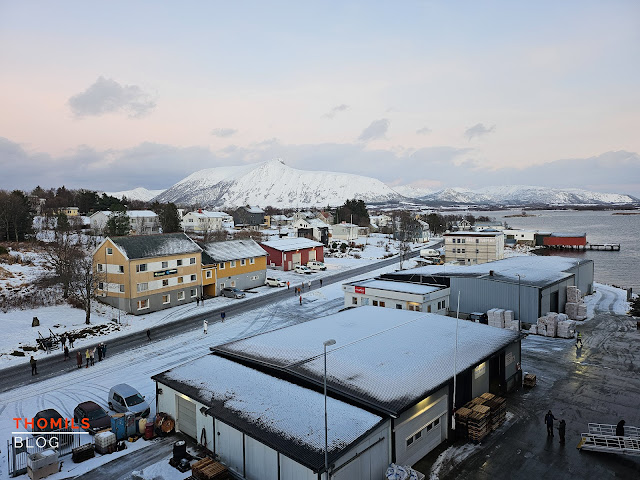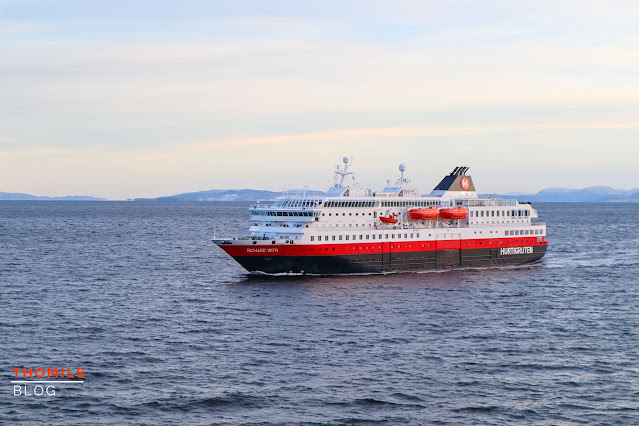The History of the Coastal Route
So what exactly is this “Hurtigrute” that you’ve been harping on about forever? No one actually asked me that question, but I’ll go ahead and answer it anyway. The term is Norwegian and literally means fast route or express route. It refers to a coastal shipping route running along the Norwegian coast and, confusingly, also to a shipping company called Hurtigruten that operates along this route. It is also widely regarded as one of, if not the most scenic sea journey in the world. However, its importance goes far beyond beautiful scenery, but in order to explain that I’ll need to expand on things quite a bit.
The Norwegian coast is rightly renowned for its breathtaking beauty. From deeply cut fjords to towering mountains and majestic glaciers, it is nothing short of spectacular, something I can now say from personal experience. However, this impressive landscape, shaped by hundreds of millions of years of glaciation and geological uplift, has also posed a massive problem for the people living in this beautiful but forbidding land. Overland travel is difficult and, in some cases, effectively impossible, as is large scale agriculture. The only effective way to travel between many of the farther flung parts of what is now Norway is by sea, meaning that shipping has been a lifeline for coastal communities for centuries.
 |
| The waters of the Norwegian coast can be pretty nasty at times, and you really need to know what you’re doing! |
Whilst there had been attempts at regular sailings along the entire Norwegian coast, and whilst there was plenty of shipping in general stemming from both the stockfish trade and fur trade with Sami peoples in Norway’s far north, by 1893, there was still no reliable shipping service that could link the far North to the rest of the country. This changed in 1893.
 |
| Where it all began. The small port of Risøyhamn is where the foundation of the coastal route was laid. |
Born in Tromsø in 1846, Richard With was well acquainted with the rough waters around the Lofoten Islands. Since his childhood, Richard had sailed on merchant ships between Bergen in the south of Norway and Vardø on the icy shores of the Barents Sea, eventually becoming a captain himself. In 1882, using proceeds from building up a flourishing trading business in the port of Risøyhamn, With founded the Vesteraalske Dampskibsselskab A/S (VDS), or Vesterålen Steamship Company and purchased that company’s first ship, MS Vesterålen. For the next ten years, the company, and MS Vesterålen, would ply the rough waters of the neighbouring Lofoten and Vesterålen archipelagos, not just trading, but also taking depth soundings and creating detailed navigational charts for this area, in many cases for the first time. Then, in 1893, Richard With decided to take the next step. Back in 1891, VDS had won a government contract for a mail packet route between the city of Trondheim and Vadsø, a port city on the frigid shores of Varangerfjord, close to the border with the Russian Empire. And on July 2nd 1893, MS Vesterålen cast off from Trondheim on the first voyage on this mail route, although it initially only went as far as Hammerfest. It would be the first time that a regular shipping service was established between southern and northern Norway, and it would cut mail transit times down from Weeks in summer and months in winter to a mere seven days. It was also generally the quickest way to travel along the coast, leading to the moniker of Hurtigrute that persists to this day.
Ever since that July day in 1893, mail packet ships and coastal ferries have kept up a steady schedule along the Norwegian coast. The route has expanded and contracted, eventually serving ports as far flung as Stavanger in the south or Kirkenes in the east. The latter remains the northern terminus of the coastal route up until the present day. I’m not going to give a full history of the route, there are others that are far more qualified for that. However, ever since the route was started, it, and the companies that operate on it, have been a lifeline for many of the more remote communities along the route. And whilst the latter half of the 20th century brought many changes to Norway, the importance of the coastal route has never diminished.
 |
| MS Richard With, bearing the name of the founder of VDS, is one of the ships operated by Hurtigruten, the other company besides Havila operating on the coastal route. |
Nowadays, two companies operate on the route. One is Hurtigruten, named after the coastal route itself, and formed in 2006 after the merger of several other coastal shipping companies and the successor to Richard With’s original Vesterålen Steamship Company. The other company is Havila Kystruten, who were founded in 2017 started operating on the coastal route in December 2021. Together, both companies operate a total of eleven ships on the coastal route, four from Havila and seven from Hurtigruten. Every day, one of these ships leaves Bergen for Kirkenes whilst another leaves Kirkenes on its southbound voyage to Bergen, calling at a total of 34 stops in between those two ports. And whilst postal service on these ships was stopped in the 1980s, they still fly the official ensign of a Norwegian mail ship.
Nowadays, many of the passengers are tourists, the coastal route being a very popular cruise for many people. However, whilst the modern ships on the route are undoubtedly built to cater to this audience, often resembling shrunken down cruise ships more than anything else, they are still primarily coastal ferries. As such, underneath the cruise-like exterior, they are distinctly practical and utilitarian. Every ship has a large cargo hold accessed via a cargo door and ramp on the port side. Every ship has vehicle spaces in the hold for coastal travelers that need to take their car with them, as well as refrigerated hold space for perishable cargo. There’s a height-adjustable folding gangway to allow for boarding in the many austere ports along the way, as well as plenty of seating for day passengers. And make no mistake, these ships are still an important supply link for many isolated communities. Norway has made great strides in expanding its infrastructure to better serve these communities, from its extensive network of short-runway regional airports or STOLports to the construction of headline-grabbing undersea tunnels or spectacular bridges, but aircraft small enough to land on these short-runway airports are by necessity small and the rugged terrain and harsh weather conditions further north make road construction a daunting prospect to put it mildly. As such, the coastal route is often simply the most convenient option.
And speaking personally, that’s what makes this service so compelling. Modern cruise ships are floating all-inclusive resorts whose only purpose is to provide mindless entertainment to thousands of people at once and who often do their best to make passengers forget that they are at sea. They require massive infrastructure and services in their ports of call whilst providing relatively little in the way of benefits for the communities they visit. And they’re frequently massive, violating every sense of scale or proportion. The ships on the coastal route meanwhile are small by necessity, as they have to serve what are essentially fishing harbours with narrow entrances and short piers. They’re not flashy, don’t provide massive shows in multi-story theaters, sport entire aqua parks or roller coasters. They’re comfortable, yes, but not flashy. Above all, they’re utilitarian. And they have an actual purpose.
I think this is what makes these ships, and the route, so attractive, even to people, like my late parents, who are put off, or even disgusted, by whatever monstrosities the likes of Aida, Carnival, P&O or Disney put to sea. The ships still have a human scale, and you get the chance to see the real Norway, rather than a sanitized and hypermarketed version, even if you never leave the ship. This is also why documentaries about the coastal route are so popular back in Germany. That, together with the stories my dad told me, is how I first learned about the hurtigrute. Ever since those stories, and that documentary, taking a journey along the route has been a dream of both me and my parents.








Comments
Post a Comment